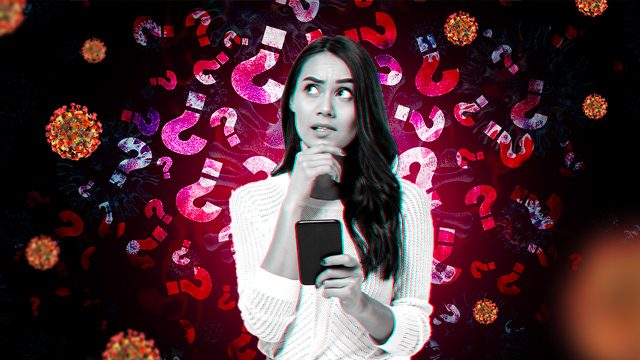SUMMARY
This is AI generated summarization, which may have errors. For context, always refer to the full article.

At the rate we get and pass around information during this lockdown, we are mimicking the frenzy of the “normal” lives we have had before the lockdown. So it is so important that we can make sense of what we get because we may act or not act on the basis of this information. (READ: Luzon lockdown: What are the do’s and don’ts?)
But you have to do something first. You need to swallow or at the very least, set aside your own personal opinions to see facts and/or scientific information for what they are. Because no matter how strongly you feel about your opinion, it will not change scientific facts because they are what they are regardless of your feelings. Only then can we move forward and see how we can make things better.
These are some of the things that are being passed around, and here’s how we can make sense of it.
-
Blood type A is supposedly more susceptible to COVID-19 and blood type O is the least susceptible
This is UNPROVEN. This news was based on a preliminary draft by researchers in Wuhan, China and has not been “peer-reviewed.” Peer-review is a built-in self-correction mechanism in science so that others who are studying the many aspects of the same thing can bear on the results of the study. The study does exist but the authors of the study themselves cautioned that this cannot be used in clinical practice, because even if they were tested in over 2,000 patients in Wuhan, that number is not enough to generalize for the number of infections we have now, and in the way it is growing. It is also limited only to cases in Wuhan. We have to expand the cases studied and compare.
What to do: Do not feel emboldened to go out just because you are blood type O. And do not panic if your blood type is A.
-
A Japanese-developed drug called “Avigan” as a treatment
This is still being TESTED to be conclusive and widely applied to patients. This was based on the statements of doctors in Shenzen and Wuhan, China who used it on only 340 patients. It is a drug originally developed for the flu and its generic name is favipiravir. It works the way many anti-viral drugs do – it cripples the RNA material that the virus replicates. It is encouraging as they have reported that it seems to greatly treat those with mild to moderate symptoms. But the drug company doing the testing itself has declined to comment when asked by the media.
What to do: We let the experts do their thing. Many are in a mad rush to come up with treatments and even cures. None so far have yet to be proven conclusive and safe enough to be widely applied, beyond the tests they are doing now.
-
Malaria drug chloroquine and its derivative hydrochloroquie as effective treatments
This is still being TESTED to be conclusive and widely applied to COVID-19 patients. Again, they work generally the same way anti-virals do. Chloroquinine has been developed for malaria since the 1940’s. They cripple the RNA mechanism of the virus so that it does not replicate. The effectivity and safety parameters of these drugs, in terms of dosage, among other things, are known for malaria and lupus but are still being tested for COVID-19. (READ: U.S. fast-tracking antimalarials to treat coronavirus)
What to do: Do NOT take these anti-malaria pills if you think you have COVID-19.
-
Bananas are said to prevent COVID-19
This is UNPROVEN, not to mention funny. There have been no studies that prove that if you eat bananas, you will not get COVID-19. This may have come up because you need a robust immune system to fight COVID-19 as there is no treatment and cure yet. But a robust immune system is not powered by only bananas. It is a result of eating healthy – in favor of vegetables and fruits, which we should be doing with or without this pandemic. (READ: FALSE: Video saying bananas ‘prevent coronavirus’)
What to do: Go ahead and eat bananas but do NOT count on them to shield you from COVID-19.
-
Coronavirus is airborne
It has ALWAYS been airborne. “Airborne” means you can catch it when you breathe. So droplets from sneezing or coughing that are in the air or have landed on surfaces after traveling in the air can have the virus. BUT the virus does NOT fly constantly like a bird.
What to do: The distance a droplet travels after a cough or sneeze is about a meter, so that is the distance you have to maintain with people all the time. In places where you cannot maintain a social distance, a surgical mask that has a filter small enough to catch the virus before it enters your mouth, nose, or eyes should be worn. That is why health workers who deal with patients up close in hospitals and those who work in essential services close to other people need to wear these masks, and those who are mostly staying at home with no contact with anyone sick need not wear them. And wash your hands with soap and water, as often as you can.
You do not need a PhD to understand what the scientists are saying and also what they are NOT saying. We can do this. We have no excuse. We have a lot more time to think. – Rappler.com
Maria Isabel Garcia is a science writer. She has written two books, “Science Solitaire” and “Twenty One Grams of Spirit and Seven Ounces of Desire.” You can reach her at sciencesolitaire@gmail.com.
Add a comment
How does this make you feel?
There are no comments yet. Add your comment to start the conversation.